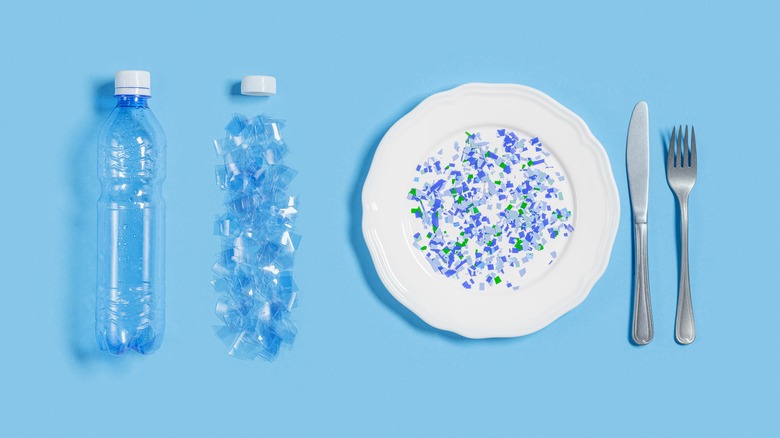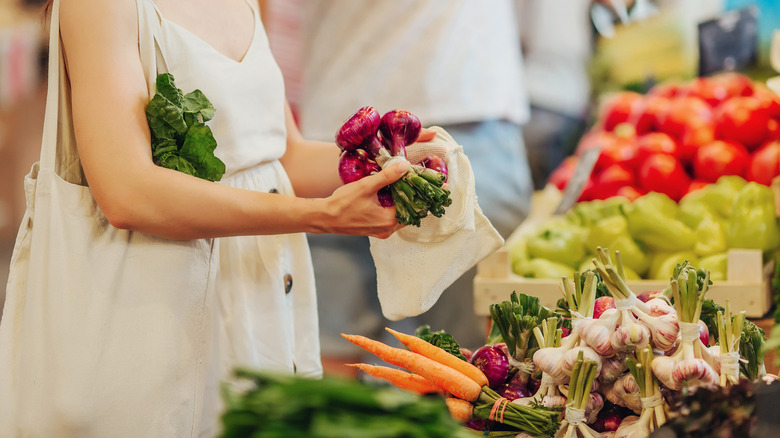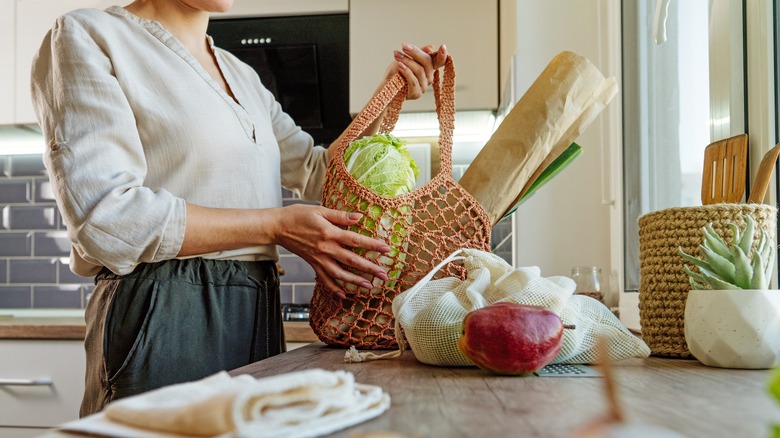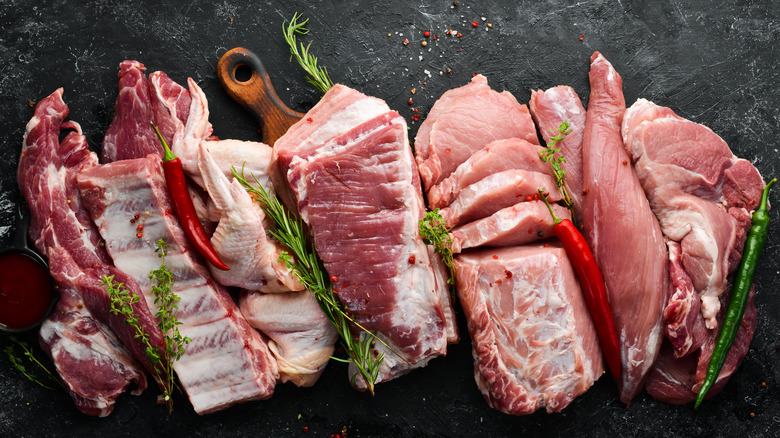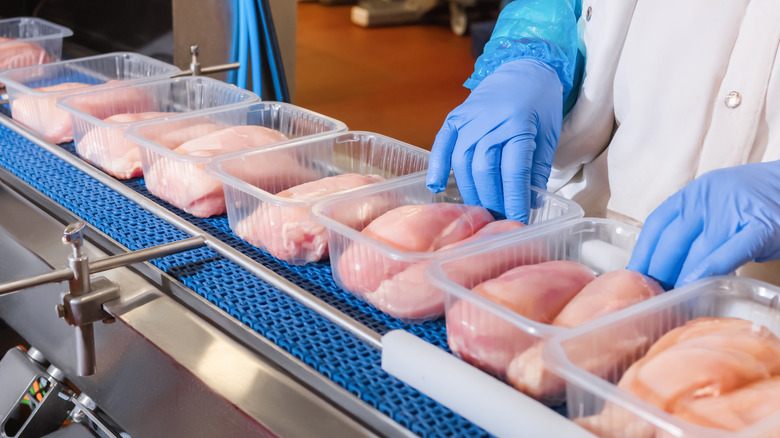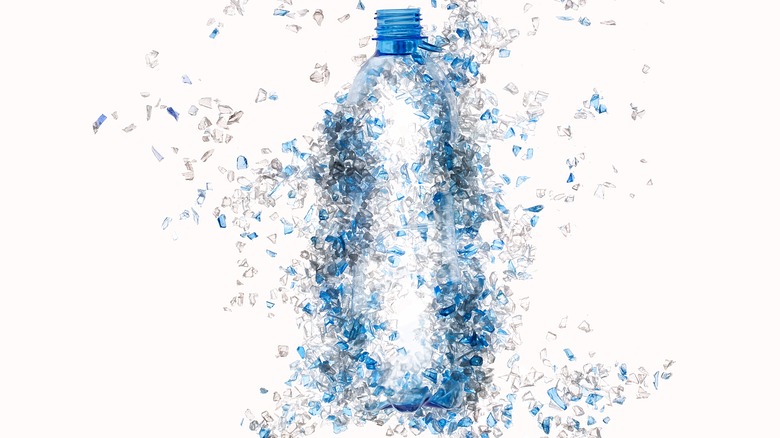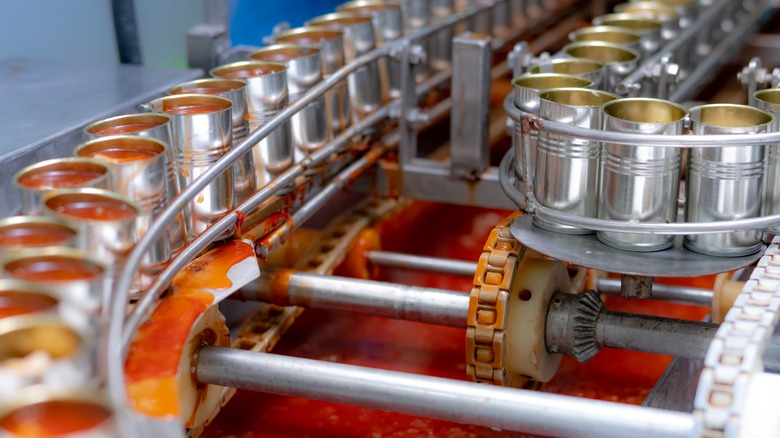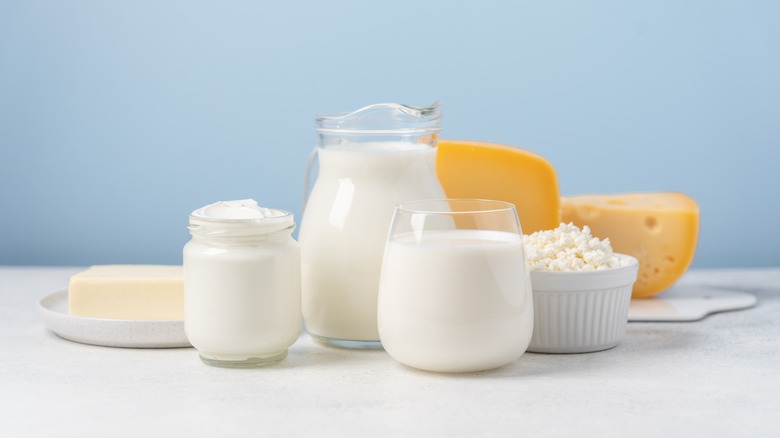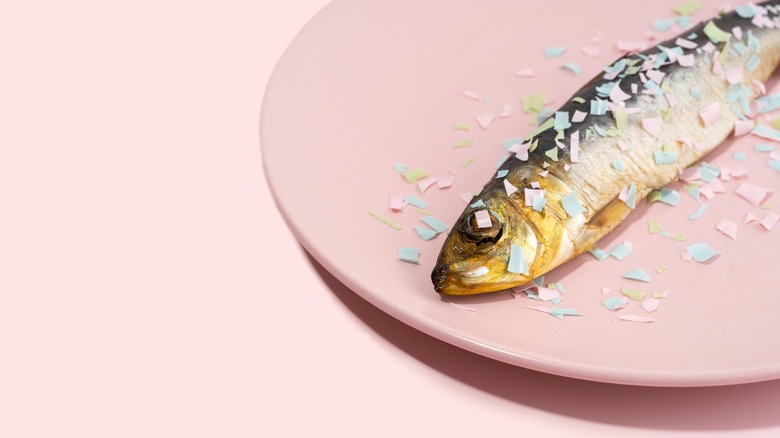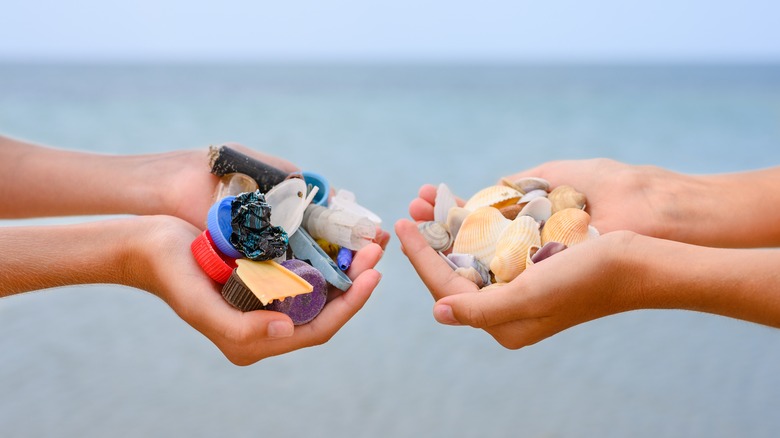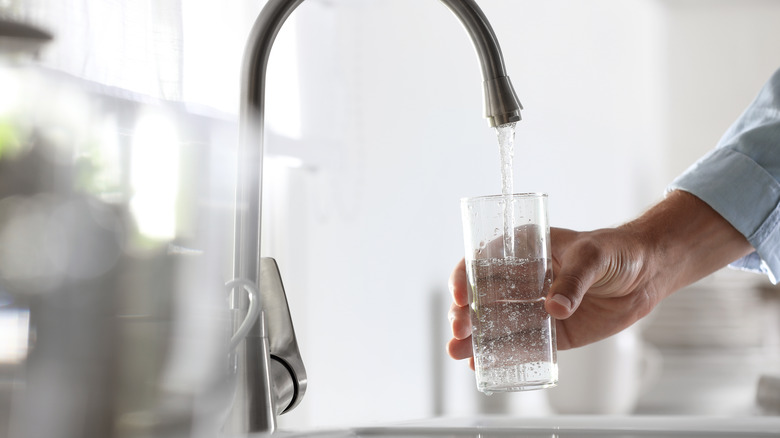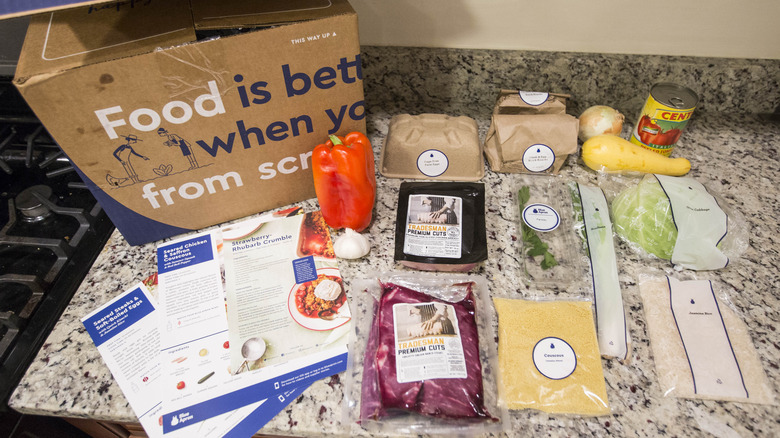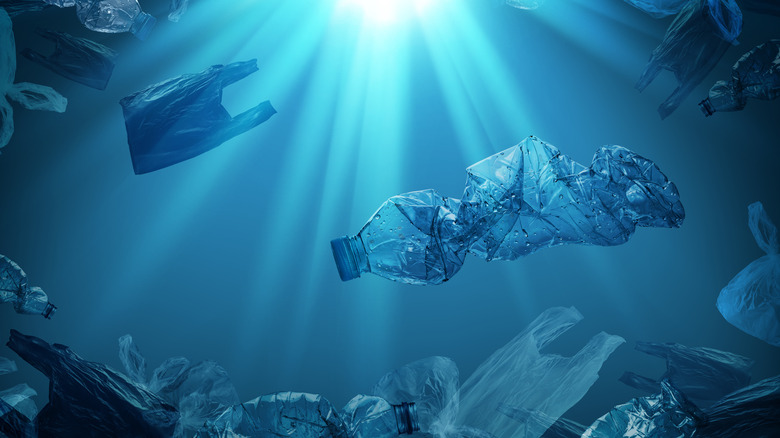14 Every Day Tips To Reduce The Consumption Of Microplastics
Plastic is everywhere. It's extremely visible in the styrofoam container that holds your takeout, in the wrapping around the meat and produce in the grocery store, but it's also present in so many hard-to-see facets of modern life. Plastic surrounds your toothpaste, is weaved into the fabric of your shower curtain, houses the life-saving pills you pick up at the pharmacy, and is hidden in the lining of your aluminum beer can. When we're done with it, all that plastic has to go somewhere, and, unfortunately, a shocking amount of it is not being recycled. The EPA's most current data is from 2018, which reports a recycling rate of only 8% of the 35.7 million tons of plastic produced in the United States. Meanwhile, 27 million tons of plastic made its way to the landfill.
Recent news that the average person consumes a credit card's worth of plastic every week microplastics has shocked many of us into confronting the plastics crisis. National Geographic defines microplastics as the result of the breakdown of larger plastics, producing tiny plastic particles that find their way into everyday products. They can be inhaled in the air we breathe and the food we eat, from seafood to our meat supply.
So how do we avoid it? By making small, incremental changes that eliminate plastics from our lives. Get started with these everyday tips to reduce the consumption of microplastics.
Shop locally
One of the best ways to avoid plastics starts with your local farmers market, and shopping locally was the biggest piece of advice offered by Kristin Lawless, author of the 2018 book "Formerly Known As Food: How the Industrial Food System is Changing Our Minds, Bodies, and Culture." After realizing the omnipresence of plastics in our food supply, Lawless spent a decade interviewing researchers to understand how the chemicals used in plastics affect our health. "These experts have documented over and over that these environmental chemicals are interfering with our hormonal systems," she told us, "potentially leading to all sorts of chronic disease, from diabetes to cancers."
While she acknowledges that it's difficult for many Americans to find the time and money to shop locally, Lawless told us that avoiding conventional grocery stores is a great start to reducing the consumption of microplastics. "When we buy foods from our local farmers, we are bypassing a lot of unnecessary plastics," she explains. Local markets allow you to bring your own reusable bags and buy directly from the source, avoiding plastics found in pre-bagged bread, carrots, or bags of salad mix. Most farmers also tend to avoid packaging in plastic along the way, transporting goods in reusable crates instead of relying on plastic along the supply chain.
Use reusable bags when shopping
Using a reusable grocery is a great start to reducing microplastics. The Center for Biological Diversity points out that more than 87% of the 730,000 tons of plastic bags produced in 2015 ended up in landfills and oceans. Not only do these bags pollute the oceans and harm wildlife, but they also don't break down completely, turning into microplastics instead.
As of 2021, eight states have banned the use of single-use plastic bags, forcing consumers to bring their own bags to the grocery store (via the National Conference of State Legislations) — since that was written, New Jersey also passed a single-use plastic bag ban. This is a great start, but most states only ban plastic bags at the check-out lines. It's just as important to use reusable bags for other grocery items, like produce, bulk goods, and the meat counter. Lawless specifically recommends staying away from pre-packaged produce as well. "I do not recommend buying lettuce, salad mixes, green beans, baby carrots, etcetera, in pre-packaged plastic bags," Lawless told us. "Not only are you being exposed to all the chemicals in those bags, but these products are often recalled for food-borne illnesses due to unsanitary packing conditions in manufacturing plants." Not only that, but studies have shown that plastic packaging does nothing to extend the product's shelf life, and this practice is a massive contributor to plastic pollution, which leads to the production of more microplastics.
Be choosy about the meat you buy
Farmers markets don't just offer fruits and vegetables: Most markets have at least one rancher present with options for poultry, beef, pork, and eggs. While you'll find that locally-sourced meat is significantly more expensive than the commodities available at the grocery store, the price tag may be well worth it when it comes to reducing microplastic consumption.
Researchers at Vrije Universiteit Amsterdam (VUA) found plastic in the bloodstream of cows and pigs, which led to finding microplastic in the animal's milk and packaged meat. The animals used in the blood tests were all fed pellets and shredded feed that contained plastic. British farmer Andrew Rock told The Guardian that he contacted the manufacturer after he noticed plastic fragments in his animal food and was told that, "the fragments were not a mistake, but in fact, a legal part of the recycling process that turns waste food, still packaged, into animal feed."
If you eat meat, knowing what feed the animals eat can have such a direct impact on your personal health is a great reason to get to know your local rancher. Use the opportunity to ask questions about how they're raising their animals and whether they use the plastic-ridden feed in their operation. "We need to change the way we produce food immediately," Lawless urges. "It needs to be re-localized and regionalized so we aren't so reliant on large corporations, fossil fuels for transport, and all the excess packaging this requires."
Look for products that aren't packaged in plastic
An alarming number of foods come packaged in plastic. Take the meat department at your local grocery store, for example. Unless you're purchasing items from the butcher counter, the meat or poultry available at the store is packaged on styrofoam trays. A study in Food Packaging and Shelf Life found that these trays are usually made from extruded polystyrene (XPS). This material releases microplastics that get stuck between the meat and plastic wrap, becoming "difficult to remove by mere rinsing."
Plastic packaging doesn't just refer to meat, either. Consumer Reports warns that removing the wrapper from plastic-wrapped, pre-made sandwiches can release fragments of plastic into the air and the food. Plastic food containers with a recycling code of 3, 6, and 7 may contain harmful chemicals (unless they're labeled "biobased" or "greenware"). Even peanut butter isn't safe: The product has to be heated when it's poured into the jars, causing plastic, chemical residues, and additives to leach into the product (via 7 News).
Luckily, you have options. Ask around at the farmers market for ranchers who sell whole animals, and see if they have plastic-free options. If you can't commit to a whole animal, support a local butcher or meat market that packages in wax paper or a plastic-free butcher paper that can be composted. When it comes to grocery store items, simply avoid products with plastic packaging altogether. Skip any plastic-wrapped items and opt for goods packaged in glass instead.
Stay away from plastic bottles
Saying no to single-use plastic bottles is one of the easiest ways we can reduce our consumption of microplastics. It's undeniably convenient to reach for a plastic bottle (like the ones you'll find in the vending machine filled with water, soda, or sports drinks). Unfortunately, it's not as safe to drink from plastic bottles as you'd think. A 2018 study published in Frontiers in Chemistry found that 93% of the water bottles tested were contaminated with microplastics, and Statistia lists water as the biggest known source of microplastic ingestion.
Instead, pick up a reusable water bottle and clean it every day to avoid bacteria buildup. When it comes to reusable bottle materials, you'll want to steer clear of BPA-free plastic and tritan copolyester if you're trying to avoid plastics, as well as most aluminum water bottles, which also contain undisclosed liner materials made from enamel, resin, polymer, or epoxy lining (via Bulletin Bottle). Glass or stainless-steel bottles are your best bet for plastic-free options.
If you're a big soda drinker, opt for soda sold in glass bottles. Better yet, make your own at home with carbonated water and flavored syrup. If you plan to make it regularly, it may be worth picking up a soda maker instead of buying glasses of soda water at the grocery store. Sports drinks can be homemade, too, so don't think you're stuck with water just because you're avoiding plastic bottles.
Use reusable coffee mugs
We're not trying to burst all of your bubbles, but paper coffee cups aren't on the safe list if you're trying to avoid consuming microplastics, either. Most paper products used with liquids contain a hidden plastic liner, from paper milk cartons to ice cream containers, paper plates, and paper cups (via My Plastic-Free Life). The paper cup you pick up at your local coffee shop contains a 5% polyethylene lining that's designed to keep the cup from disintegrating as you sip. Unfortunately, the hot coffee causes the lining to break down, releasing trillions of nanoparticles of microplastics per liter (via a study in the Environmental Science & Technology Journal).
If it's possible to carve out some extra time in your morning, switch to a ceramic mug and slowly sip your morning coffee as you plan out your day. Of course, coffee on the go is a reality for many Americans, so we recommend swapping the paper cup for a stainless-steel reusable travel mug. Some cafes prohibited the use of personal coffee cups for the first two years of the COVID-19 pandemic, but most coffee shops have returned to allowing the practice. Starbucks has been playing with a borrow-a-cup concept as an effort to reduce its carbon footprint, so, hopefully, we'll see more support for reusable mugs from other coffee chains, as well.
Remove plastic before heating
If your take-out order arrives packed in plastic containers, or you meal-prep and store food in plastic, you'll want to remove the food or beverage before heating it up in the microwave. According to Healthline, plastics are primarily made from oil and natural gas, but often contain additives to reinforce the plastic, increasing its flexibility or durability. One of the more common additives is BPA (bisphenol A), which breaks down more quickly when it's heated (like when used in the microwave). This can leach plastics into the body and disrupt the body's hormones. You'll know if your plastic container contains BPA if it has a recycling code "7" stamped on the back.
Healthline goes on to warn that BPA-free plastics aren't necessarily safe, either, as they can also leach chemicals into your food. That's why it's so important to remove the food or drink from any plastic container before heating it up. Transfer the food to a plate (or a bowl or microwave-safe glass for liquids). To help the food reheat evenly, try the microwave trick of spreading the food out and creating a donut hole in the middle.
Avoid products in metal or aluminum cans
In many ways, canned food changed the way we eat. Canning makes it possible to preserve the harvest, saving the summer's bounty for a time when food is scarce in the winter (via History). But when it comes to products canned in metal or aluminum, you'll want to steer clear. Lawless warns that metal cans are lined with BPA (bisphenol-A) or an alternative BPA-free chemical. This is especially destructive when it comes to canned tomatoes or oily fish like sardines or anchovies. "The acidity in tomatoes causes the chemicals to leach at a higher rate," she explains.
Unfortunately, this is also true of carbonated beverages, like beer or sparkling authority. "A leading authority on BPA, Fred vom Saal, told me that he would never drink beer out of a can," Lawless notes. A study in the Public Library of Science found microplastics in the liquid of 12 different brands of American beers.
It is possible to find jarred tomato sauce in glass instead of metal, but it's hard to find diced or whole tomatoes without metal packaging. Instead of relying on the store, try getting into the practice of canning your own food. Ask the farmers at the market if they do bulk tomato sales at the end of the season when tomatoes are abundant. When it comes to fish and carbonated beverages, seek these products out in glass containers instead of metal or aluminum.
Store food in glass or aluminum foil instead of plastic
Are you starting to notice a trend here? Foods stored in plastic containers can leach harmful chemicals and microplastics into food, leading to the direct consumption of microplastics (via Environmental Nanotechnology, Monitoring & Management). Sometimes, we have a choice about whether or not to buy a product in glass or plastic. Milk or yogurt in glass containers may be more expensive, but Lawless highly suggests opting for this type of packaging with high-fat items, like yogurt, milk, cream, and butter. "When foods are high in fat, they leach chemicals from plastics more readily," she says, "so think about this when prioritizing where to avoid plastic."
Other times, we don't have a choice, and our only option is to purchase something in plastic packaging. It's often hard to avoid plastic packaging for items like cheese or meat, "I have still yet to find a rancher who packages their meat in something other than plastic," Lawless admitted, "but they must exist somewhere." In those cases, she suggests transferring the product into glass jars as soon as you bring them home.
The American Academy of Pediatrics also suggests using aluminum foil, glass, or food-grade silicone containers for storing leftovers and creating a plastic-free kitchen. While silicone is not a perfect alternative because it's not biodegradable, Eco & Beyond says it's a better alternative to plastic.
Consider the types of fish you ingest
It shouldn't be any surprise that plastic pollution is a problem in our oceans. According to Greenpeace, microplastics from our plastic disposables are too small to be filtered out of sewage treatment plants. So, they end up making their way to the ocean, where they break down into particles tiny enough to be consumed by planktonic organisms. From there, the plastic makes its way up the food chain until it contaminates most of the fish we eat.
According to Ocean Conservancy, these microplastics aren't just consumed and excreted by the fish; the study found evidence of plastic fibers in the filets and liver of several fish species. Studies are still ongoing, and the effects are thought to be small: You might consume 1.48 grams of microplastics in fish compared to 94.37 grams in bottled water, and you'll likely inhale significantly more microplastics than consuming a pound of fish twice a week. That said, researchers found microplastic in all of the samples they studied. While previous studies have provided evidence that larger, top-predator fish contain more mercury, this study's data discovered the opposite: Larger fish have more microplastics overall, but smaller fish have more microplastics per gram of tissue.
Think twice before eating certain shellfish
We love shellfish, but it might not be the best option if you're trying to reduce the consumption of microplastics. According to Newport Bay Conservancy, bi-valve mollusks (like oysters, clams, and mussels) are filter feeders. That means they bring water in and pump it through an internal filter that removes microscopic particles, feeding themselves and cleaning the water at the same time. Unfortunately, microplastics are small enough to get caught in those filters, so shellfish can bring a shocking amount of microplastics to the dinner table. A study in the Marine Pollution Bulletin found that countries with high shellfish consumption ingested up to 11,000 microplastic particles a year, compared to the average of 1,800 microplastic particles in countries with low shellfish consumption.
According to a paper in Environmental Health Perspectives, mussels have the highest level of microplastic contamination, followed by oysters and clams. Crustaceans like shrimp and crab are also contaminated, but they tend to contain fewer microplastics because we don't consume the gills and gastrointestinal tracts like we do with bivalves.
Start filtering your tap water
We've already discussed ditching bottled water to reduce the consumption of microplastics, but you may also want to filter the water that comes out of the tap. A 2019 analysis for the World Wildlife Federation (performed by Dalberg and the University of Newcastle Australia) found that a significant amount of our microplastic consumption comes from water. When analyzing U.S. tap water, they found plastic fibers present in 94.4% of samples, and U.S. water sources had twice as many fibers per 500 milliliters compared to European water sources.
Lawless told us her family uses a Big Berkey to filter their water. These filters are known for purifying water in addition to filtering it, so they can remove microscopic bacteria and viruses from drinking water. Berkey has not performed tests that confirm if its filters remove microplastics, although the brand says it's "highly likely" since microplastics are smaller than molecules its confirmed filtering out.
Looking for other options? "Some people swear by reverse osmosis filtration systems," Lawless told us, "though I haven't tried those yet." Reverse osmosis works by moving water over a set of filters that remove sediment, reduce taste and odors, and separate the water from physical contaminants as small as an atom.
Skip meal delivery kits
Meal delivery kits soared in popularity during the pandemic when many restaurants were closed and people were staying close to home. While they do make home-cooked meals convenient for anyone short on time, Lawless urges people to avoid them. "Meal delivery kits are responsible for a tremendous amount of plastic waste," she told us after she observed how the packaged ingredients increase single-use plastic. Each ingredient comes in an individual plastic container — chopped-up garlic and shredded ginger, for example, would each be packaged separately from the meat and other produce items.
This does more than just create waste. A study in Scientific Reports found that microplastics can be generated from opening plastic containers and bags. It doesn't matter if you use scissors or your hands to tear open the package, either: Microplastics were generated with all opening methods. That means avoiding plastic-wrapped or packaged products is a simple way to reduce the contents' microplastic level. So instead of ordering that meal delivery kit, buy plastic-free products like a head of garlic or whole ginger root and chop it up yourself.
Eliminate household plastics in general
While we don't eat household plastics like grocery bags, shampoo bottles, plastic containers, or plastic wraps, reducing your and your family's dependence on plastic, in general, is necessary for the fight against microplastics. GRID-Arendal (a Norway-based non-profit environmental communications center) advises that microplastic generation does come from primary sources (like microbeads in facial scrubs), but it also comes from secondary sources, including the breakdown of larger plastic pieces. That means that every piece of plastic that goes from our household into the trash or recycling bin has the potential to create more microplastic.
"When you see plastic you should see oil," Lawless told us. "You should see the destruction of the earth and its many species, you should see the damage to your own body and your children's bodies." Every piece of microplastic comes from us, which means we're the only ones that can reduce its presence. By increasing our awareness of the plastics crisis and adopting some of these tips into our everyday lives, we can work together to collectively reduce our dependence on plastic, working towards eliminating microplastics from our food sources.
